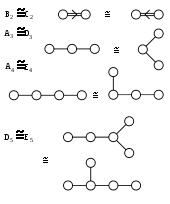Exceptional isomorphism
In mathematics, an exceptional isomorphism, also called an accidental isomorphism, is an isomorphism between members ai and bj of two families (usually infinite) of mathematical objects, that is not an example of a pattern of such isomorphisms.[note 1] These coincidences are at times considered a matter of trivia,[1] but in other respects they can give rise to other phenomena, notably exceptional objects.[1] In the below, coincidences are listed in all places they occur.
Groups
Finite simple groups
The exceptional isomorphisms between the series of finite simple groups mostly involve projective special linear groups and alternating groups, and are:[1]
- the smallest non-abelian simple group (order 60);
- the second-smallest non-abelian simple group (order 168) – PSL(2,7);
- between a projective special orthogonal group and a projective symplectic group.
Groups of Lie type
In addition to the aforementioned, there are some isomorphisms involving SL, PSL, GL, PGL, and the natural maps between these. For example, the groups over have a number of exceptional isomorphisms:
- the alternating group on five elements, or equivalently the icosahedral group;
- the symmetric group on five elements;
- the double cover of the alternating group A5, or equivalently the binary icosahedral group.
Alternating groups and symmetric groups

There are coincidences between alternating groups and small groups of Lie type:
These can all be explained in a systematic way by using linear algebra (and the action of on affine -space) to define the isomorphism going from the right side to the left side. (The above isomorphisms for and are linked via the exceptional isomorphism .) There are also some coincidences with symmetries of regular polyhedra: the alternating group A5 agrees with the icosahedral group (itself an exceptional object), and the double cover of the alternating group A5 is the binary icosahedral group.
Cyclic groups
Cyclic groups of small order especially arise in various ways, for instance:
- , the last being the group of units of the integers
Spheres
The spheres S0, S1, and S3 admit group structures, which arise in various ways:
- ,
- ,
- .
Coxeter groups

There are some exceptional isomorphisms of Coxeter diagrams, yielding isomorphisms of the corresponding Coxeter groups and of polytopes realizing the symmetries. These are:
- A2 = I2(2) (2-simplex is regular 3-gon/triangle);
- BC2 = I2(4) (2-cube (square) = 2-cross-polytope (diamond) = regular 4-gon)
- A3 = D3 (3-simplex (tetrahedron) is 3-demihypercube (demicube), as per diagram)
- A1 = B1 = C1 (= D1?)
- D2 = A1 × A1
- A4 = E4
- D5 = E5
Closely related ones occur in Lie theory for Dynkin diagrams.
Lie theory
In low dimensions, there are isomorphisms among the classical Lie algebras and classical Lie groups called accidental isomorphisms. For instance, there are isomorphisms between low-dimensional spin groups and certain classical Lie groups, due to low-dimensional isomorphisms between the root systems of the different families of simple Lie algebras, visible as isomorphisms of the corresponding Dynkin diagrams:
- Trivially, A0 = B0 = C0 = D0
- A1 = B1 = C1 , or
- B2 = C2, or
- D2 = A1 × A1, or ; note that these are disconnected, but part of the D-series
- A3 = D3
- A4 = E4; the E-series usually starts at 6, but can be started at 4, yielding isomorphisms
- D5 = E5
- Spin(1) = O(1)
- Spin(2) = U(1) = SO(2)
- Spin(3) = Sp(1) = SU(2)
- Spin(4) = Sp(1) × Sp(1)
- Spin(5) = Sp(2)
- Spin(6) = SU(4)
See also
- Exceptional object
- Mathematical coincidence, for numerical coincidences
Notes
- ↑ Because these series of objects are presented differently, they are not identical objects (do not have identical descriptions), but turn out to describe the same object, hence one refers to this as an isomorphism, not an equality (identity).
References
- 1 2 3 Wilson, Robert A. (2009), "Chapter 1: Introduction", The finite simple groups, Graduate Texts in Mathematics 251, 251, Berlin, New York: Springer-Verlag, doi:10.1007/978-1-84800-988-2, ISBN 978-1-84800-987-5, Zbl 05622792, 2007 preprint; Chapter doi:10.1007/978-1-84800-988-2_1.